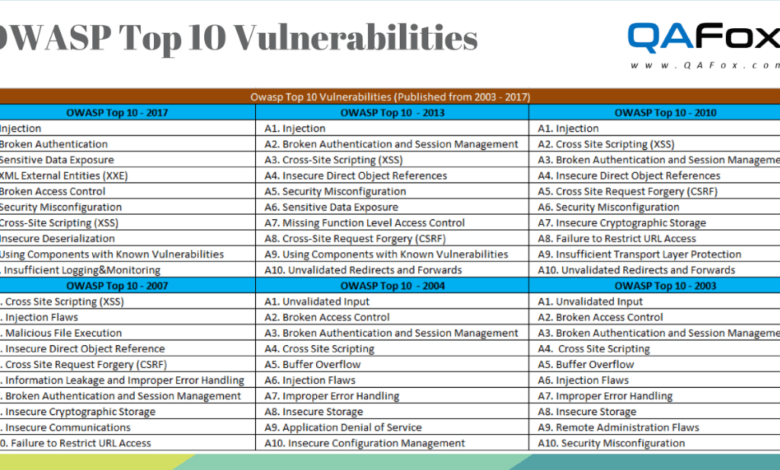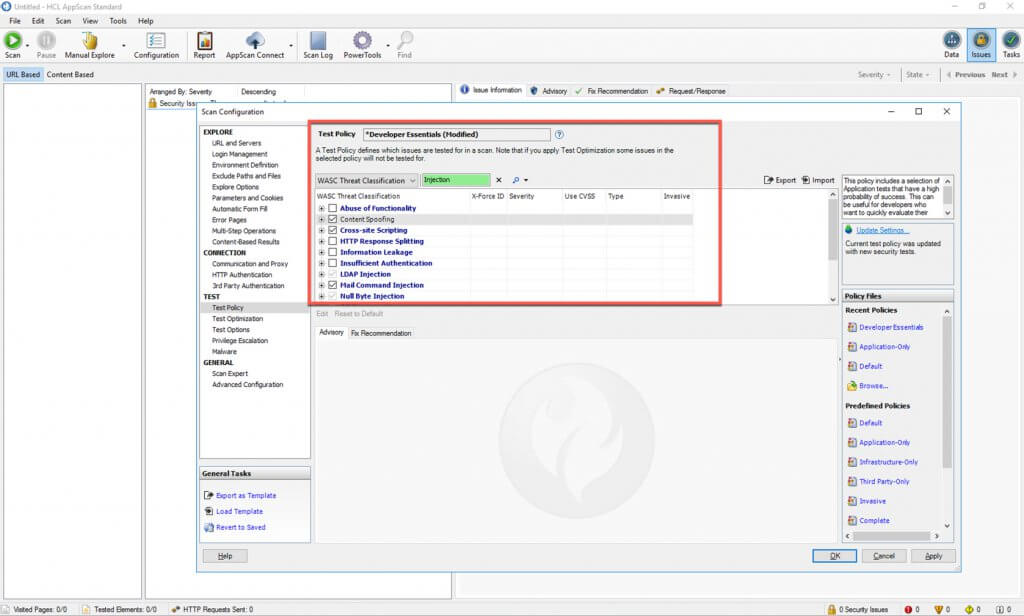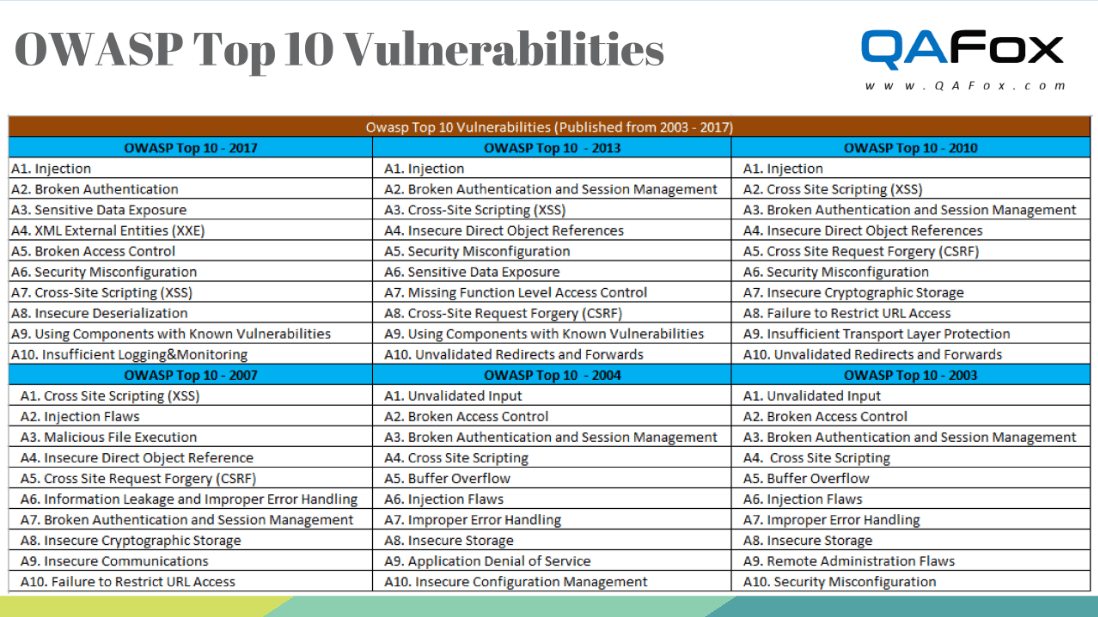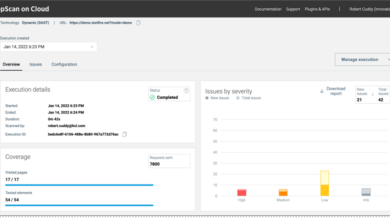
AppScan and the OWASP Top 10 Focusing on SQL Injection
Appscan and the owasp top 10 a focus on sql injection – AppScan and the OWASP Top 10: A Focus on SQL Injection – sounds intense, right? But don’t worry, I’m breaking down this crucial topic in a way that’s both informative and (dare I say) fun. We’ll dive into how AppScan helps us hunt down those sneaky SQL injection vulnerabilities, a top threat on the OWASP list. Think of this as your friendly guide to navigating the sometimes-scary world of application security.
This post will cover everything from understanding what SQL injection is and how it works, to seeing AppScan in action, and finally, mastering the art of fixing these vulnerabilities before they cause any serious damage. We’ll explore different types of attacks, look at some real-world code examples (don’t worry, I’ll explain them!), and even discuss the limitations of AppScan and how to use it effectively as part of a broader security strategy.
Get ready to level up your app security game!
Introduction to AppScan and OWASP Top 10

Application security is paramount in today’s digital landscape. Protecting applications from vulnerabilities is crucial, and two key players in this arena are AppScan and the OWASP Top 10. This section explores their functionalities and their intertwined roles in securing applications.AppScan is a dynamic application security testing (DAST) tool that helps identify security vulnerabilities in web applications. It simulates attacks to pinpoint weaknesses, providing developers with actionable insights to remediate risks.
Its functionalities encompass various testing methods, including crawling the application to map its structure, identifying potential vulnerabilities through automated scans, and generating detailed reports outlining the severity and location of identified flaws. This allows developers to focus their efforts on the most critical issues.The Open Web Application Security Project (OWASP) Top 10 is a regularly updated list of the most critical web application security risks.
These risks represent common vulnerabilities that, if exploited, can severely compromise application security and lead to data breaches, financial losses, or reputational damage. The list serves as a valuable benchmark for developers and security professionals, prioritizing efforts towards addressing the most prevalent and dangerous threats.AppScan plays a crucial role in mitigating the OWASP Top 10 risks. By identifying vulnerabilities such as SQL Injection, Cross-Site Scripting (XSS), and Cross-Site Request Forgery (CSRF), AppScan directly addresses many of the risks Artikeld in the OWASP Top 10.
The tool’s automated scanning capabilities significantly speed up the vulnerability discovery process, allowing for quicker remediation and reducing the window of exposure to potential attacks. The detailed reports generated by AppScan provide developers with the information needed to effectively patch vulnerabilities and strengthen the application’s security posture.
AppScan’s Vulnerability Identification Capabilities
AppScan utilizes a combination of techniques to identify security vulnerabilities. These include static analysis (examining the application’s code without execution), dynamic analysis (testing the running application), and interactive testing (manually verifying potential vulnerabilities). The tool’s sophisticated algorithms and extensive vulnerability database enable it to detect a wide range of flaws, including those listed in the OWASP Top 10. For instance, AppScan can identify SQL injection vulnerabilities by analyzing how the application handles user input and database interactions.
It can detect potential vulnerabilities by injecting malicious code into forms and observing the application’s response. This allows developers to proactively address potential issues before they can be exploited by malicious actors.
The Significance of the OWASP Top 10
The OWASP Top 10 provides a prioritized list of the most critical web application security risks. This ranking is based on real-world data and expert analysis, reflecting the most prevalent and dangerous vulnerabilities encountered in applications. The consistent updating of this list ensures it remains relevant and addresses emerging threats. By focusing on the vulnerabilities listed in the OWASP Top 10, developers can effectively mitigate the most significant risks, resulting in more secure applications.
The list’s widespread adoption across the industry provides a common language and understanding of the most critical security concerns.
AppScan’s Role in OWASP Top 10 Risk Mitigation
AppScan’s ability to identify and report on the OWASP Top 10 vulnerabilities directly contributes to their mitigation. The tool’s automated scanning significantly reduces the time and effort required to identify these risks. By providing detailed reports with clear remediation advice, AppScan empowers developers to address these vulnerabilities efficiently and effectively. This proactive approach to security significantly reduces the likelihood of successful attacks targeting these common vulnerabilities.
Regular use of AppScan as part of a comprehensive security testing strategy minimizes the risk profile of applications, aligning directly with the goals of addressing the OWASP Top 10.
Focusing on SQL Injection within the OWASP Top 10

SQL injection remains a persistent and dangerous threat, consistently ranking highly in the OWASP Top 10 vulnerabilities. Understanding its mechanics and mitigation strategies is crucial for building secure web applications. This section delves into the specifics of SQL injection, exploring its various forms and offering practical examples to illustrate its impact.SQL injection exploits vulnerabilities in how applications handle user-supplied data within SQL queries.
Instead of simply executing the intended query, an attacker crafts malicious input that alters the query’s logic, potentially allowing them to read, modify, or delete data they shouldn’t have access to. This often leads to data breaches, unauthorized access, and significant security compromises.
Types of SQL Injection Attacks
Different attack vectors exist, each requiring a unique approach to detection and prevention. These variations leverage the application’s response to manipulate database interactions.
| Vulnerability Type | Example Code | Explanation | Mitigation Technique |
|---|---|---|---|
| In-band SQL Injection | $query = "SELECTFROM users WHERE username = '" . $_GET['username'] . "'"; |
The attacker directly injects malicious SQL code into the query, which is then reflected in the application’s response. For example, an attacker might append ' OR '1'='1 to the username parameter, causing the query to return all users. |
Use parameterized queries or prepared statements. These separate data from SQL code, preventing the injection of malicious commands. |
| Error-based SQL Injection | $query = "SELECTFROM users WHERE username = '" . $_GET['username'] . "'"; |
The attacker exploits error messages returned by the database to glean information about the database schema and data. By injecting specific code that causes an error, the attacker can extract sensitive information. For example, an attacker might use ' AND 1=2 UNION SELECT password FROM users-- |
Disable error reporting to the end-user. Implement robust input validation and sanitization. |
| Blind SQL Injection | $query = "SELECTFROM users WHERE username = '" . $_GET['username'] . "'"; |
The attacker cannot directly see the results of their injected code. Instead, they infer information based on changes in the application’s response time or other indirect indicators. This often involves timing attacks or boolean-based blind SQL injection. For example, an attacker might inject code that alters the response time based on the truthiness of a condition involving sensitive data. | Employ input validation and parameterized queries. Implement rate limiting to mitigate timing attacks. |
| Union-based SQL Injection | $query = "SELECTFROM users WHERE id = " . $_GET['id']; |
This type uses the UNION operator to combine the results of multiple queries. An attacker could use this to retrieve data from other tables that they shouldn’t have access to. For example, ' UNION SELECT password, username FROM users -- |
Use parameterized queries and carefully control the columns returned by the query. Implement least privilege database access controls. |
Vulnerable Code Examples and Mitigation
The examples in the table above highlight common vulnerabilities. The core issue is the direct concatenation of user-supplied data into SQL queries. This practice allows attackers to manipulate the query’s structure and logic. Always sanitize user inputs and employ parameterized queries or prepared statements to prevent SQL injection vulnerabilities. These techniques treat user-supplied data as data, not as executable code, preventing the injection of malicious commands.
Implementing robust input validation is also critical in preventing this type of attack.
AppScan’s Capabilities in Detecting SQL Injection
AppScan, a leading static and dynamic application security testing (DAST) tool, offers robust capabilities for detecting SQL injection vulnerabilities. It leverages a combination of techniques to identify potential weaknesses in an application’s code and its interaction with databases, providing developers and security professionals with valuable insights to mitigate risks. This analysis focuses on how AppScan identifies, tests for, and reports SQL injection flaws.AppScan employs a multi-faceted approach to SQL injection detection, going beyond simple pattern matching.
It analyzes application behavior during runtime, injecting specifically crafted payloads to observe responses. This dynamic analysis, combined with static code analysis in some versions, provides a comprehensive view of potential vulnerabilities. The effectiveness of AppScan’s detection hinges on its ability to accurately model the application’s interaction with the database and identify deviations from expected behavior that indicate SQL injection vulnerabilities.
AppScan’s SQL Injection Detection Methods
AppScan utilizes several methods to detect SQL injection vulnerabilities. These include analyzing application traffic for suspicious patterns, such as the presence of unexpected s or database error messages within the application’s responses. It also employs techniques like fuzzing, where it systematically modifies input parameters to identify injection points. Additionally, AppScan leverages its knowledge base of known SQL injection attack vectors to cross-reference against identified code patterns and runtime behaviors.
For example, it might detect vulnerabilities by sending specially crafted inputs that include single quotes or semicolons to see if they cause unexpected database interactions or errors.
AppScan’s SQL Injection Reporting Mechanisms
AppScan presents SQL injection findings in a structured and detailed manner, facilitating remediation efforts. The reports typically include the following:
- Vulnerability Location: Precise identification of the affected URL, input field, or code segment where the SQL injection vulnerability resides.
- Severity Level: A rating indicating the potential impact of the vulnerability (e.g., critical, high, medium, low), based on factors such as the sensitivity of the data affected and the ease of exploitation.
- Detailed Description: A comprehensive explanation of the vulnerability, including the type of SQL injection (e.g., in-band, error-based, blind), the affected database, and the potential consequences of exploitation.
- Proof of Concept (POC): Illustrative examples of the malicious input that triggered the vulnerability, demonstrating how an attacker could exploit the flaw. This might involve showing the specific SQL query that was executed as a result of the malicious input.
- Remediation Recommendations: Specific and actionable advice on how to fix the vulnerability, including suggested code changes or configuration adjustments. This could involve parameterized queries, input validation, or escaping user-supplied data.
- Affected Data: Identification of the database tables and columns that could be accessed or manipulated through the vulnerability.
The reports are often presented in a user-friendly interface, allowing security teams to easily navigate and understand the findings. They can be exported in various formats (e.g., PDF, HTML, XML) for further analysis and sharing. The level of detail provided allows developers to quickly pinpoint and address the vulnerabilities.
Mitigating SQL Injection Vulnerabilities using AppScan Findings
AppScan, a powerful static and dynamic application security testing (DAST) tool, provides invaluable insights into potential vulnerabilities within your applications. Understanding how to leverage AppScan’s findings to effectively mitigate SQL injection risks is crucial for building secure software. This involves not only fixing the immediate vulnerabilities but also implementing broader secure coding practices to prevent future occurrences.
Effective mitigation of SQL injection vulnerabilities requires a multi-pronged approach combining remediation of specific AppScan findings with the adoption of robust secure coding practices. This ensures both immediate patching of identified vulnerabilities and long-term prevention of similar issues.
Secure Coding Practices to Prevent SQL Injection
Preventing SQL injection vulnerabilities starts with adopting secure coding practices throughout the software development lifecycle (SDLC). This includes using parameterized queries or prepared statements, input validation and sanitization, and employing least privilege principles for database access. Ignoring these fundamental principles significantly increases the risk of successful attacks.
Parameterized queries are a cornerstone of SQL injection prevention. Instead of directly embedding user-supplied data into SQL queries, they treat data as parameters, separating data from the query structure. This prevents malicious code from being interpreted as SQL commands. Input validation ensures that all user-provided data conforms to expected formats and data types, rejecting anything outside of those parameters.
Finally, the principle of least privilege dictates that database users should only have the necessary permissions to perform their tasks, minimizing the impact of a potential breach.
Step-by-Step Remediation of AppScan SQL Injection Findings
AppScan provides detailed reports outlining identified SQL injection vulnerabilities, including the affected code segments and the nature of the vulnerability. A systematic remediation process is vital to ensure complete and effective patching.
- Identify the Vulnerability: Carefully review AppScan’s report, noting the specific location, type, and severity of the SQL injection vulnerability.
- Reproduce the Vulnerability: Attempt to reproduce the vulnerability reported by AppScan to confirm its existence and understand its impact. This helps to validate the AppScan findings and ensure accurate remediation.
- Implement the Fix: Apply the appropriate remediation technique based on the vulnerability’s nature. This may involve implementing parameterized queries, input validation, or other secure coding practices. For example, changing a vulnerable query like
"SELECTto a parameterized query like- FROM users WHERE username = '" + username + "'"
"SELECT - FROM users WHERE username = ?" using a prepared statement mechanism.
- Retest the Application: After implementing the fix, thoroughly retest the application using AppScan or other security testing tools to verify that the vulnerability has been successfully eliminated. This step ensures that the fix is effective and doesn’t introduce new vulnerabilities.
- Document the Changes: Maintain comprehensive documentation of the vulnerability, the implemented fix, and the testing results. This documentation aids in future audits and helps prevent similar vulnerabilities from arising.
Comparison of SQL Injection Mitigation Approaches
Several approaches exist for mitigating SQL injection risks, each with its strengths and weaknesses. Choosing the best approach depends on the specific application context and development environment.
While parameterized queries and prepared statements are generally considered the most effective approach, input validation and output encoding also play crucial roles. Input validation helps prevent malicious data from entering the system, while output encoding prevents the malicious data from being rendered as executable code in the output. A layered approach combining these techniques provides the strongest defense.
| Mitigation Approach | Strengths | Weaknesses |
|---|---|---|
| Parameterized Queries | Highly effective, prevents most SQL injection attacks. | Requires understanding of database drivers and APIs. |
| Input Validation | Prevents malicious data from entering the system. | Can be complex to implement correctly for all data types. |
| Output Encoding | Prevents malicious data from being rendered as executable code. | May not be sufficient on its own to prevent all SQL injection attacks. |
Advanced Techniques and Considerations: Appscan And The Owasp Top 10 A Focus On Sql Injection
AppScan, while a powerful tool, isn’t a silver bullet. Its effectiveness in detecting SQL injection vulnerabilities depends heavily on the complexity of the attack and the application’s architecture. Understanding its limitations is crucial for a comprehensive security posture. Sophisticated techniques can easily evade basic static and dynamic analysis.AppScan’s reliance on predefined patterns and heuristics means it may struggle with novel or obfuscated SQL injection attempts.
Furthermore, the accuracy of its findings can be affected by various factors, leading to both false positives and false negatives. A thorough understanding of these limitations, coupled with the use of complementary testing methods, is essential for a robust security assessment.
AppScan Limitations in Detecting Sophisticated SQL Injection Attacks
AppScan primarily uses static and dynamic analysis to identify potential vulnerabilities. Static analysis examines the application’s code without execution, while dynamic analysis observes the application’s behavior during runtime. However, sophisticated SQL injection attacks often employ techniques designed to bypass these analyses. These include techniques like parameterized queries that AppScan might miss if they are not correctly implemented or if the application uses unusual database interaction methods.
Additionally, attacks using encoded or encrypted SQL commands, or those leveraging blind SQL injection (where the attacker infers data from the application’s responses rather than directly retrieving data), are significantly harder for AppScan to detect. The effectiveness of AppScan decreases dramatically when dealing with complex, multi-layered applications or those utilizing custom frameworks or libraries. This necessitates a layered security approach that goes beyond relying solely on AppScan.
False Positives and False Negatives in AppScan’s SQL Injection Detection
False positives occur when AppScan flags a vulnerability that doesn’t actually exist. This might happen due to the tool misinterpreting legitimate database interactions as malicious attempts. For example, AppScan might flag a section of code that uses string concatenation for logging purposes, mistaking it for an SQL injection vulnerability. False negatives, on the other hand, occur when AppScan fails to identify a real vulnerability.
This is more concerning and can happen when an attacker uses advanced evasion techniques, or when the application’s architecture masks the injection point. Regular code reviews and manual penetration testing are necessary to validate AppScan findings and reduce the risk of overlooking actual vulnerabilities.
The Importance of Combining AppScan with Other Security Testing Methods
Relying solely on AppScan for SQL injection detection is insufficient. A multi-layered approach is necessary to achieve comprehensive security. AppScan should be seen as one component of a larger security testing strategy.The following methods complement AppScan and enhance the overall security assessment:
- Manual Penetration Testing: Experienced security professionals manually test the application, exploring beyond the automated capabilities of AppScan. This allows for the discovery of vulnerabilities that might be missed by automated tools.
- Static Application Security Testing (SAST): SAST tools analyze the application’s source code to identify potential vulnerabilities before runtime. This is a valuable complement to AppScan’s dynamic analysis.
- Dynamic Application Security Testing (DAST): DAST tools, such as AppScan, test the running application to identify vulnerabilities. While AppScan is a DAST tool, using another DAST tool with a different approach might reveal different vulnerabilities.
- Software Composition Analysis (SCA): SCA tools identify known vulnerabilities in open-source and third-party components used within the application. SQL injection vulnerabilities can often reside in these components.
- Runtime Application Self-Protection (RASP): RASP tools monitor the application’s runtime behavior and can detect and block SQL injection attempts in real-time.
Illustrative Examples of SQL Injection and AppScan’s Response

Let’s examine a common scenario where a web application is vulnerable to SQL injection and see how AppScan can help detect and remediate the issue. Understanding these practical examples is key to effectively securing your applications.Imagine a simple login page for a fictional online bookstore. The page accepts a username and password, and submits them to a backend script using a GET request.
The script then uses these parameters directly within a SQL query to authenticate the user. This is a classic example of insecure coding practices.
Vulnerable Login Script and SQL Injection
The vulnerable login script might look something like this (simplified for illustrative purposes):
`$username = $_GET[“username”];$password = $_GET[“password”];$query = “SELECT
FROM users WHERE username = ‘$username’ AND password = ‘$password'”;
$result = mysql_query($query);`
This code is vulnerable because it directly incorporates user-supplied input into the SQL query without proper sanitization or parameterized queries. A malicious user could input a modified username like `’ OR ‘1’=’1` which would alter the query to:
`SELECT
FROM users WHERE username = ” OR ‘1’=’1′ AND password = ”`
This modified query will always return true, granting the attacker access regardless of the password.
AppScan’s Detection and Reporting, Appscan and the owasp top 10 a focus on sql injection
AppScan, during a security scan, would simulate this attack vector by injecting various malicious payloads into the username and password fields. It would observe the database interaction, recognizing the altered SQL query and the subsequent unauthorized access granted. The report would then clearly identify the vulnerability, specifying:* The vulnerable URL: The exact address of the login page.
The vulnerable parameter
The username and password parameters in the GET request.
The SQL injection vector
The specific malicious input used to exploit the vulnerability (`’ OR ‘1’=’1` in this case).
The severity
A high severity rating, indicating the critical nature of the vulnerability.
Detailed evidence
Screenshots or logs showing the successful exploitation and the database response. AppScan would likely also provide information on the specific SQL statement executed, highlighting the vulnerable portion.
Remediation Process
Fixing this SQL injection vulnerability requires using parameterized queries or prepared statements. This prevents direct embedding of user input into the SQL query. The revised code should look like this:
`$username = $_GET[“username”];$password = $_GET[“password”];$stmt = $mysqli->prepare(“SELECTFROM users WHERE username = ? AND password = ?”);$stmt->bind_param(“ss”, $username, $password);$stmt->execute();$result = $stmt->get_result();`
This approach uses placeholders (`?`) to represent the user-supplied values. The `bind_param` function then securely inserts these values into the query, preventing SQL injection. Additionally, input validation should be implemented to ensure the username and password conform to expected formats and lengths. This further enhances security by preventing unexpected or malicious data from reaching the database.
Closing Summary
So, there you have it – a whirlwind tour of AppScan and its role in tackling the ever-present threat of SQL injection. Remember, security is a journey, not a destination. While AppScan is a powerful tool, it’s just one piece of the puzzle. Combining it with other security testing methods, secure coding practices, and a healthy dose of vigilance is key to keeping your applications safe.
Stay tuned for more security adventures!
FAQ Section
What is OWASP?
OWASP (Open Web Application Security Project) is a non-profit organization focused on improving the security of software. Their Top 10 list highlights the most critical web application security risks.
Can AppScan detect all SQL injection vulnerabilities?
No, AppScan, like any automated tool, has limitations. Highly sophisticated or obfuscated attacks might evade detection. Manual code review and penetration testing are still important.
What are false positives in AppScan?
False positives are instances where AppScan flags a potential vulnerability that doesn’t actually exist. Careful review of the reported findings is crucial to avoid unnecessary remediation efforts.
Is AppScan suitable for all types of applications?
AppScan supports various application types, but its effectiveness can vary depending on the technology stack and complexity of the application. It’s best to check AppScan’s documentation for specific compatibility details.




